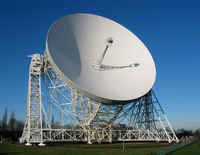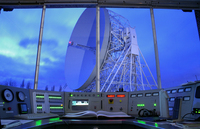Anatomy
The most striking feature of the Lovell Telescope is the huge white bowl that can be seen for many miles around. This bowl, fashioned in the shape of a paraboloid, is the part of the telescope that gathers incoming radio waves (see below). When the telescope is pointed towards a radio source in the sky, waves arriving from the source are intercepted by the bowl and reflected from the steel surface into the focus box mounted on top of the central tower. Here, at the focal point of the reflector, a small aerial picks up the waves and feeds them into a sensitive radio receiver.
Steering the bowl
From the beginning, the telescope was designed to be fully steerable, so that it could be pointed to any part of the sky, right down to the horizon. Indeed, more than 60 years after it was conceived, there are only two fully steerable instruments larger than the Lovell Telescope, one in Germany (Effelsberg) and one in the United States (Green Bank).
The whole telescope rotates on circular railway tracks, while the bowl, supported on either side by two towers, can be tilted at any angle from the horizon to the zenith. In this way the bowl can be directed at any point in the sky. The horizontal (azimuth) drive is powered by two 50 horse power electric motors at the foot of each tower, while the vertical (elevation) drive is powered by two motors at the top of each tower, and by two more motors driving the wheel girders beneath the bowl.
The two motions are independent, with a maximum drive rate of 15 degrees a minute in azimuth and 10 degrees in a minute in elevation. These fast rates are used when the telescope is being moved from one astronomical object to another, but when tracking a source, the elevation and azimuth drives together have to produce a slow, smooth motion of no more than a quarter of a degree a minute to compensate for the rotation of the Earth. The telescope can track objects in any part of the sky, except for a small region around the zenith.
Computer control
A control computer calculates the required drive rates to follow each radio source. The drive motors are servo-controlled, so there is a continuous check that the correct rate has been achieved. The position of the telescope is constantly monitored and fed back to control computer to ensure that the telescope is pointing correctly.
For good tracking the pointing accuracy should be about a twentieth of the resolution. Since the resolution is proportional to the wavelength being received (see below), it follows that the pointing accuracy is more critical at shorter wavelengths. The control computer is able to correct for pointing errors caused by the telescope bowl sagging under its own weight as it moves up and down. In this way the pointing errors can be kept to about 10 arcsec.
The Lovell Telescope can be controlled from any of six locations at Jodrell Bank, but the centre of operations is the control room which is manned 24 hours a day by one of a team of controllers. The controller is a technician who is responsible at all times for the safe operation of the telescope. During normal operation the telescope is under the control of the observing room, but if something goes wrong, such as a malfunction or impending bad weather, the ever-watchful controller can call a halt to the observing and park the telescope in a safe position with the bowl pointing to the zenith and the brakes applied.
The work begins

One of the radio receivers installed in the focus box
Once the telescope is on source, the astronomical work can begin. The radio receiver in the focus box is kept cooled to a few degrees above absolute zero. This ensures that the very weak signal from the sky is not swamped by noise from the receiver itself. The amplified signal is sent down a cable to the observing room, where it is available to the astronomer.
Depending on the nature of the observing programme, the signal can be used in many ways. Its strength can be measured, and its polarization; two basic properties of electromagnetic waves. A spectrum can be made and a lot more information deduced about about the source of emission. In most cases the processed signals are stored on magnetic tape or disc for later analysis on Jodrell Bank's network of powerful computers.
Collecting radio waves
Radio waves arriving from space are very weak. They have to be collected over a large area and brought to a focus, where an antenna, similar in principle to a TV aerial, captures them and turns them into an electrical signal. The larger the collecting area the more sensitive the telescope will be and the weaker the waves that can be received.
A common way of doing this is to use a reflector in the shape of a shallow bowl.The surface is formed into a paraboloid (a three dimensional parabola), so that all waves arriving from a distance are reflected to a point at the focus. The sensitivity is proportional to the square of the diameter. So a 100-m telescope is four times as sensitive as a 50-m telescope.
The smoothness of the surface is very important. To achieve a sharp focus, any unevenness over the surface should ideally be no more than a twentieth of the shortest wavelength the telescope is designed to receive. At the same time, the bowl should keep its shape as it is moved up and down. This was a major engineering challenge for the designers of the Lovell Telescope as astronomers sought to work at even shorter wavelengths.




